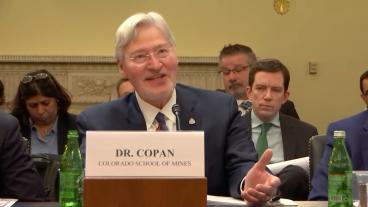Mines faculty examine the integration of mining, refining for domestic critical mineral production

According to the Department of Energy’s Critical Minerals Program, the demand for critical minerals is expected to skyrocket in coming years. They’re the building blocks of clean energy technology and the key ingredients for innovation in the field.
Production of these minerals in the U.S. lags behind China, which produces nearly 60 percent of the world’s critical minerals. If the U.S. wants to stay competitive in the clean energy market, domestic production is crucial, which means the country needs more mines.
“We know we need these minerals for the energy transition and to address climate change,” said Nicole Smith, a cultural anthropologist and associate professor of mining engineering at Mines. “The question is, can we produce these minerals in a way that ensures environmental and social injustices are not repeated or new ones aren’t created?”
Smith, along with Mines faculty and colleagues at partner institutions, is focusing on this important question as part of a new research project. Smith is lead investigator and is joined by Associate Professor Elizabeth Holley and Research Assistant Professor Aaron Malone, both in Mining Engineering, as well as Jihye Kim, assistant professor of metallurgical and materials engineering. The project is supported by a $750,000 grant from the Alfred P. Sloan Foundation.
To ensure domestic mining sites are more efficient and to reduce supply chain risks, mining companies in the US are proposing vertically integrated operations that combine mining and refining phases. Smith and her team are investigating the social and technical factors related to the development of these operations and how they impact local communities and Indigenous populations.
“In the effort to secure domestic supply chains of critical minerals, achieving the disparate goals of mineral production and equity presents major challenges,” Smith said. “Our project takes an interdisciplinary approach to understanding the ways in which companies, communities, and regulators are thinking about and addressing these challenges.”
Research will look specifically at projects for nickel and cobalt refining, minerals that are often mined together and are critical to clean energy technologies, like lithium-ion batteries. The Payne Institute for Public Policy’s 2024 State of Critical Minerals Report cites the International Energy Agency’s predictions of an increased demand by 2040 in critical minerals needed to grow the clean energy sector. The demand for nickel and cobalt is expected to double in that time over current demand.
The three-year research project is being done in partnership with researchers at Fort Lewis College, located in Durango, Colorado. Collaborators from Fort Lewis include Michelle Larkins, assistant professor of environment and sustainability; Kathleen Hilimire, associate professor of environment and sustainability; and Carma Claw, assistant professor of management. Fort Lewis is a Native –American-Serving Non-Tribal Institution. Faculty from Fort Lewis will be particularly important to the research project’s goals in better understanding themes of environmental justice and how these mining and refining operations may impact Indigenous stakeholders, Smith said.
“Are these projects incorporating the concerns of Indigenous and other communities? Are decisions about these projects being made in collaboration with tribal and local government officials and to what extent?” Smith said. “Historically, production on or near tribal lands has not taken those populations into consideration. That’s where some of the tension lies that we’re trying to understand.”
The Sloan Foundation-supported project is being conducted alongside other research on critical minerals, which is supported by a National Science Foundation grant. Holley is the principal investigator on that project and has been a leading voice in the national conversation around critical minerals. Holley is also currently engaged in several research projects focused on these materials and testified in September 2024 at a congressional critical minerals working group.
“Achieving increased domestic mineral production that is both environmentally sustainable and socially responsible will require innovation across the entire mining value chain,” Holley said in her testimony.
In describing the project’s focus on environmental impact, Smith referenced the Justice40 initiative, a commitment by the White House to make 40 percent of the overall benefits for many federal investments flow to disadvantaged communities that have been marginalized by underinvestment and overburdened by pollution.
“We want to better understand how industrial policies line up with government initiatives like Justice40, and where there are areas of alignment as well as incongruence,” Smith said.
The project is well under way, with the research team conducting site visits in multiple states. The project is expected to produce several academic papers, a database of the mining and refining facilities studied and presentations for conferences and government officials. In the project’s final year, Fort Lewis College will hold a symposium on Indigenous communities and the energy transition.
“How can communities benefit from and be part of the decision making around critical minerals developments?” Smith said. “That’s an important part of the bigger picture.”




